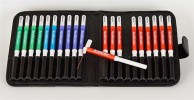Authors
M. Beaussier, Y. Parc, J. Guechot, M. Cachanado, A. Rousseau, T. Lescot, The CATCH study investigators
Lab
Department of Anaesthesiology and Critical Care Medicine, St-Antoine Hospital. Paris, France
Journal
Colorectal Disease
Abstract
Aim
The abdominal incision for specimen extraction could trigger postoperative pain after laparoscopic colorectal resections (LCR). Continuous Wound Infusion (CWI) of ropivacaine may be a valuable option for postoperative analgesia. This study was undertaken to evaluate the potential benefits of ropivacaine CWI on pain relief, metabolic stress reaction, prevention of wound hyperalgesia and residual incisional pain after LCR. A subgroup with intravenous lidocaine infusion (IVL) was added to discriminate between the peripheral and systemic effects of local anaesthetic infusions.
Method
Patients were randomly allocated to 3 subgroups; 1/CWI (0.2% ropivacaine 10 ml/h for 48h); 2/IVL (lidocaine 1.5% at 4 ml/h for 48h); 3/Control (control group).
Results
95 patients were randomized (86 patients analyzed). Postoperative pain intensity did not differ significantly between groups. Within the first 24h after surgery, morphine requirement was significantly lower in the CWI group as compared with IVL, but there was no significant difference compared with the Control group (P=0.02 and P=0.15, respectively). The area of hyperalgesia did not differ significantly between subgroups, nor did the hyperalgesia ratio which was 1.2cm[0.0-6.7] vs 1.9cm[0.4-4.0] vs 2.0cm[0.5-7.0] in the CWI, IVL and Control groups respectively. P=0.35. The number of patients reporting residual incisional pain after 3 months (3/26 vs 4/23 vs 4/23 in the CWI, IVL and Control groups respectively) did not differ significantly between the groups, nor did their metabolic stress reactions.
Conclusion
Ropivacaine CWI at the site of the abdominal incision did not provide any significant benefit either on analgesia or on the prevention of wound hyperalgesia after LCR.
BIOSEB Instruments Used:
Von Frey Filaments (Bio-VF-M)

 Douleur - Allodynie/Hyperalgésie Thermique
Douleur - Allodynie/Hyperalgésie Thermique Douleur - Spontanée - Déficit de Posture
Douleur - Spontanée - Déficit de Posture Douleur - Allodynie/Hyperalgésie Mécanique
Douleur - Allodynie/Hyperalgésie Mécanique Apprentissage/Mémoire - Attention - Addiction
Apprentissage/Mémoire - Attention - Addiction Physiologie & Recherche Respiratoire
Physiologie & Recherche Respiratoire
 Douleur
Douleur Système Nerveux Central (SNC)
Système Nerveux Central (SNC)  Neurodégénérescence
Neurodégénérescence Système sensoriel
Système sensoriel Système moteur
Système moteur Troubles de l'humeur
Troubles de l'humeur Autres pathologies
Autres pathologies Système musculaire
Système musculaire Articulations
Articulations Métabolisme
Métabolisme Thématiques transversales
Thématiques transversales Bonne année 2025
Bonne année 2025 